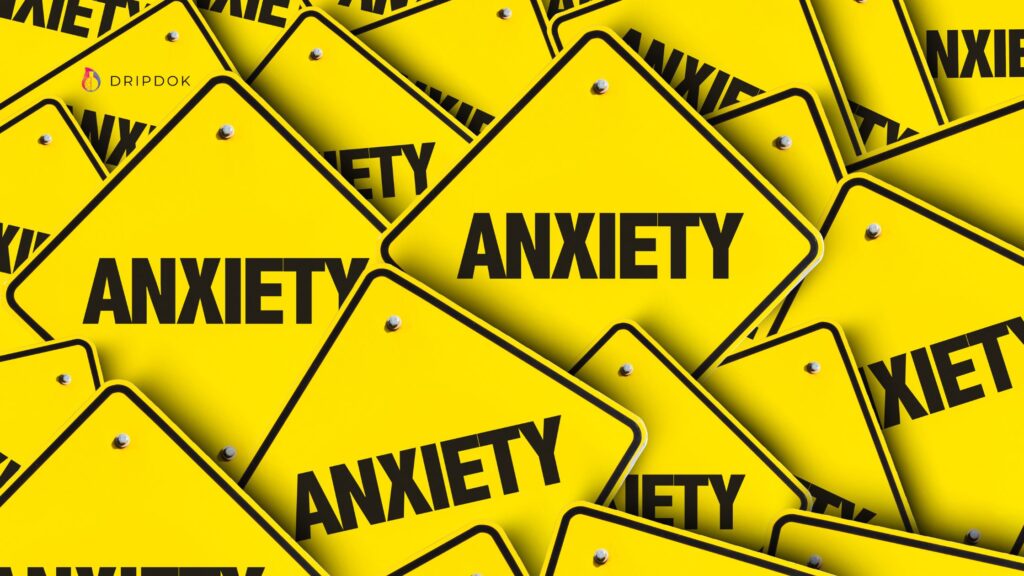In the fast-paced and demanding world we live in, it’s not uncommon for individuals to experience feelings of anxiety from time to time. However, for some, anxiety becomes a persistent and overwhelming presence, leading to the development of an anxiety disorder. In this comprehensive guide, we will delve into the intricacies of anxiety disorder, exploring its causes, symptoms, and effective coping strategies to help those affected regain control of their lives.

What is Anxiety Disorder?
Anxiety disorder, a comprehensive term encapsulating a spectrum of mental health conditions, is defined by the overwhelming presence of excessive worry, fear, and apprehension. Distinguishing itself from the commonplace anxiety triggered by stressful situations, anxiety disorders transcend the bounds of ordinary concerns, infiltrating daily life and imposing substantial challenges on an individual’s overall functionality. This category comprises diverse types of anxiety disorders, each characterized by its distinctive features.
Despite the variations, a commonality unites them—an enduring and heightened experience of fear or worry that permeates various aspects of an individual’s life, creating a pervasive impact on their emotional well-being and daily functioning. Understanding the nuanced nature of anxiety disorders necessitates a closer examination of their distinct manifestations and the shared underlying theme of persistent, intense emotional distress.
Also Read: Maximizing Deep Sleep: 4 Game-Changing Tips For Better Recovery
Types of Anxiety Disorders
- Generalized Anxiety Disorder (GAD)
Generalized Anxiety Disorder is marked by excessive, uncontrollable worry about everyday things, even when there is little or no reason to worry. Individuals with GAD often anticipate disaster and may be overly concerned about health, money, family, or work.
- Panic Disorder
Panic disorder involves recurrent, unexpected panic attacks characterized by sudden and intense fear. These attacks may be accompanied by physical symptoms such as a racing heart, shortness of breath, and a sense of impending doom.
- Social Anxiety Disorder (SAD)
Social Anxiety Disorder, also known as social phobia, is characterized by an intense fear of social situations and interactions. Individuals with SAD may fear judgment, embarrassment, or negative evaluation by others, leading to avoidance of social gatherings.
- Specific Phobias
Specific phobias involve an intense fear of a specific object or situation, such as heights, spiders, or flying. Individuals with specific phobias go to great lengths to avoid the feared object or situation.
- Obsessive-Compulsive Disorder (OCD)
Obsessive-Compulsive Disorder is characterized by intrusive, unwanted thoughts (obsessions) and repetitive behaviors or mental acts (compulsions) performed to alleviate the anxiety associated with the obsessions.
- Post-Traumatic Stress Disorder (PTSD)
PTSD can develop after exposure to a traumatic event, such as a natural disaster, assault, or military combat. Individuals with PTSD may experience flashbacks, nightmares, and severe anxiety related to the traumatic event.
Causes of Anxiety Disorder
Comprehending the underlying factors that contribute to the onset of anxiety disorders is paramount for the effective treatment and management of these complex conditions. While the precise cause of anxiety disorders may vary among individuals, a multifaceted interplay of factors emerges as influential in their development:
- Genetic Factors:
Delving into one’s family history reveals a significant aspect of the predisposition to anxiety disorders. Individuals with a familial background marked by anxiety disorders may find themselves at an elevated risk of developing these conditions. The intricate genetic tapestry contributes to the hereditary transmission of traits that may shape an individual’s susceptibility to anxiety. - Brain Chemistry:
Within the intricate landscape of the brain, neurotransmitters play a pivotal role in regulating mood and emotional states. Imbalances in neurotransmitters, particularly serotonin and dopamine, have been implicated in the genesis of anxiety disorders. These chemical irregularities can disrupt the delicate equilibrium of the brain, fostering an environment conducive to the manifestation of anxiety. - Environmental Factors:
The external milieu in which individuals navigate life is equally influential in shaping the course of anxiety disorders. Stressful life events, traumatic experiences, or a history of abuse can act as catalysts, amplifying the vulnerability to anxiety disorders. Environmental stressors contribute to the intricate web of causative factors, providing insight into the external forces that may trigger or exacerbate anxiety-related conditions. - Personality Factors:
The spectrum of personality traits presents another dimension in understanding the roots of anxiety disorders. Certain predispositions, such as shyness or reservedness, can heighten an individual’s susceptibility to anxiety. The intricate interplay between inherent personality characteristics and the external environment contributes to the nuanced development of anxiety disorders. - Medical Conditions:
The landscape of physical health intertwines with mental well-being, and chronic medical conditions, particularly those affecting the nervous system, can significantly contribute to the genesis of anxiety disorders. The intricate relationship between physical health and mental states underscores the importance of a holistic approach to understanding and managing anxiety disorders.
Recognizing the Symptoms
Recognizing and understanding the symptoms of anxiety disorder is paramount for initiating early intervention and implementing effective treatment strategies. The manifestation of symptoms is diverse, encompassing both physical and psychological aspects, with variations contingent on the specific type of anxiety disorder. An exploration of these symptoms provides valuable insights into the nuanced nature of anxiety disorders, empowering individuals and healthcare professionals to address these challenges comprehensively. Common symptoms include:
- Excessive Worry:
At the core of anxiety disorders lies a persistent and overwhelming sense of worry that extends across various facets of life. This excessive worry can permeate thoughts, creating a pervasive atmosphere of unease and anticipation. - Irritability:
Anxiety often manifests as heightened sensitivity and irritability, creating challenges in navigating interpersonal relationships. Individuals experiencing anxiety may find themselves more prone to irritability, making it difficult to manage emotions and interactions effectively. - Restlessness:
The feeling of being on edge, coupled with an inability to relax, characterizes the restlessness associated with anxiety disorders. This physical and emotional unease can contribute to a sense of perpetual tension and discomfort. - Muscle Tension:
Anxiety has tangible effects on the body, with muscle tension being a common physical symptom. This may manifest as tightness in muscles, headaches, and even stomachaches, reflecting the intricate connection between mental and physical well-being. - Difficulty Concentrating:
The cognitive impact of anxiety is evident in impaired focus and concentration. Anxiety can create a mental fog, making it challenging for individuals to concentrate on tasks, leading to decreased productivity and heightened frustration. - Sleep Disturbances:
Anxiety often disrupts the delicate balance of sleep, giving rise to insomnia or restless sleep patterns. The resulting fatigue and exhaustion contribute to a cycle of heightened stress, further exacerbating the challenges posed by anxiety disorders. - Panic Attacks:
Among the more intense manifestations of anxiety are panic attacks—sudden and overwhelming episodes of fear. These attacks are often accompanied by pronounced physical symptoms, including a racing heart and shortness of breath, creating a distressing experience that can significantly impact an individual’s daily life.
Coping Strategies for Anxiety Disorder
1. Therapy and Counseling:
- Cognitive Behavioral Therapy (CBT): CBT is a widely recognized therapeutic approach that helps individuals identify and change negative thought patterns and behaviors associated with anxiety.
- Exposure Therapy: This technique involves gradually facing and overcoming feared situations, helping individuals build resilience against anxiety triggers.
2. Medication:
- Antidepressants: Selective serotonin reuptake inhibitors (SSRIs) and benzodiazepines are commonly prescribed to manage anxiety symptoms.
- Beta-Blockers: These medications can help control physical symptoms of anxiety, such as rapid heartbeat and trembling.
3. Lifestyle Modifications:
- Regular Exercise: Physical activity has been shown to reduce anxiety by releasing endorphins, the body’s natural mood enhancers.
- Balanced Diet: A nutritious diet can positively impact mental health, providing the necessary nutrients for optimal brain function.
- Adequate Sleep: Establishing healthy sleep patterns is essential for managing anxiety.
4. Mindfulness and Relaxation Techniques:
- Deep Breathing Exercises: Practicing deep, diaphragmatic breathing can help calm the nervous system and reduce anxiety.
- Meditation and Yoga: Mindfulness practices can promote relaxation and provide tools for managing stress.
5. Social Support:
- Build a Support System: Cultivate relationships with friends and family who can provide understanding and encouragement.
- Join Support Groups: Connecting with others who share similar experiences can reduce feelings of isolation and provide valuable insights.

IV Drip Therapy for Anxiety Disorder: A Potential Adjunctive Treatment
In recent years, alternative therapies have gained attention for their potential role in managing anxiety disorders. Among these, Intravenous (IV) drip therapy has emerged as a promising adjunctive treatment option. While traditional interventions like therapy and medication remain primary components of anxiety disorder management, IV drip therapy introduces a novel approach that aims to address anxiety at a physiological level. In this section, we will explore the concept of IV drip therapy, its potential benefits for anxiety disorder, and considerations for individuals considering this treatment.
1. Understanding IV Drip Therapy:
Intravenous drip therapy involves the administration of a solution directly into the bloodstream through a vein. This method allows for the rapid and efficient delivery of essential nutrients, vitamins, and minerals that are thought to have therapeutic effects. The composition of IV drip formulations can vary, but they often include a combination of vitamins, antioxidants, and amino acids.
2. Nutrient Deficiencies and Anxiety:
Some proponents of IV drip therapy for anxiety believe that nutrient deficiencies may contribute to the development or exacerbation of anxiety symptoms. For instance, deficiencies in certain vitamins and minerals, such as B vitamins, magnesium, and zinc, have been linked to increased anxiety. IV drip therapy aims to address these deficiencies by providing a concentrated and directly absorbable form of these nutrients.
3. Potential Benefits for Anxiety Disorder:
- Rapid Absorption: IV drip therapy allows for the rapid absorption of nutrients, bypassing the digestive system. This can be particularly beneficial for individuals with digestive issues that may hinder nutrient absorption.
- Improved Energy Levels: Some formulations include B vitamins, which play a crucial role in energy metabolism. Improved energy levels can contribute to an overall sense of well-being and may help combat fatigue associated with anxiety.
- Stress Reduction: Antioxidants, such as vitamin C, are believed to have stress-reducing properties. IV drip therapy may provide an additional layer of support in managing the physiological effects of stress.
4. Considerations and Caution:
- Scientific Evidence: While some studies suggest potential benefits of certain nutrients for anxiety, the scientific evidence supporting the use of IV drip therapy specifically for anxiety disorders is limited. More research is needed to establish its efficacy.
- Individual Variation: Responses to IV drip therapy can vary among individuals. Factors such as overall health, existing nutrient levels, and the specific formulation used may influence the outcomes.
- Complementary Approach: IV drip therapy should be viewed as a complementary approach rather than a standalone treatment. It is not a replacement for evidence-based interventions like therapy and medication.
5. Consultation with Healthcare Professionals:
- Before considering IV drip therapy, individuals should consult with their healthcare provider. A thorough assessment of overall health and consideration of existing treatments are essential to determine the suitability of this approach.
- Healthcare professionals can provide guidance on the safety, potential benefits, and integration of IV drip therapy into an individualized treatment plan.
Ready to explore the potential benefits of Dripdok Anxiety IV Drip? Take the first step towards a holistic approach to anxiety management. Schedule a consultation with Dripdok today and discover how our tailored IV drip therapy can be a valuable addition to your anxiety wellness plan. Your journey to a calmer, more balanced life starts here.
We recommend completing a pre-intake form before using our services. This form helps us understand your health history. You can find the form here:
If you have questions or having issues, feel free to contact us

- Patient-Centric Care: Why Dripdok Outclasses The IV Drip Industry In Bali (Pre-Treatment Analysis)
- Discover the Hidden Powers of Exosomes: Unveiling the Intriguing Biology, Function, and Groundbreaking Biomedical Applications
Separate with commas or the Enter key.
Most Used
Current image: Anxiety Disorder, IV Drip Bali
